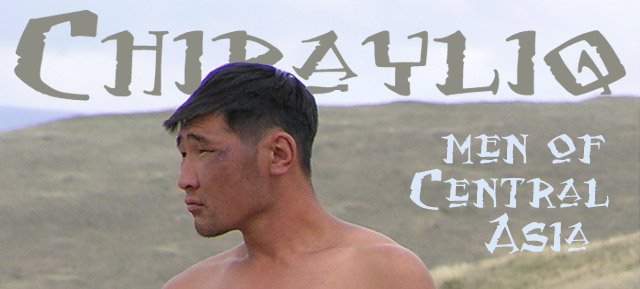
Thanks to the blog Moscow Through Brown Eyes, I was inspired to dig up some nice photos of American poet Langston Hughes' travels in early 1930's Soviet Central Asia. The Yale University Library has an online exhibition of Hughes' life (1902-1967) for starters.
 In 1932, Hughes boarded the S/S Europa with a group of African-American actors and writers on their way to the Soviet Union. Their purpose was to make a film about the plight of black people in the United States, but after long and fruitless meetings with the Soviet producers, the whole project was scrapped.
In 1932, Hughes boarded the S/S Europa with a group of African-American actors and writers on their way to the Soviet Union. Their purpose was to make a film about the plight of black people in the United States, but after long and fruitless meetings with the Soviet producers, the whole project was scrapped.Hughes took the chance to travel around Soviet-controlled Central Asia, areas that usually were not accessible to Westerners but that interested him for personal and political reasons. Hughes wanted to find a positive example of a "coloured South" to contrast with the Jim Crow south of the US. He met African-American engineers involved in the modernization of the Soviet cotton industry. He also met the Hungarian intellectual Arthur Koestler, who at the time was a member of the Communist party, but had already begun to develop his critical eye for the system. Hughes was a Communist sympathizer, although no party member - for him the dream of racial equality was so important that he preferred to look away from the harsh realities of famine and oppression. His self-critical period would come later, after WW2.
That said... maybe he was just dazzled by all the chirayliq guys he met on his travels?
 From Beinecke Rare Book and Manuscript Library's Langston Hughes collection. Described as "Group photograph of unidentified men and women in Russia, possibly Uzbekistan". See the larger original here.
From Beinecke Rare Book and Manuscript Library's Langston Hughes collection. Described as "Group photograph of unidentified men and women in Russia, possibly Uzbekistan". See the larger original here. Young writers of Central Asia, Hughes in the middle. On the backside of the photo there are descriptions in Cyrillic, which the library hasn't bothered to decipher.
Young writers of Central Asia, Hughes in the middle. On the backside of the photo there are descriptions in Cyrillic, which the library hasn't bothered to decipher.  Hughes' surprise traveling companion, Arthur Koestler. View the whole image here, plus chicken. Apparently Koestler heard someone play jazz records (this article claims it was Sophie Tucker singing "My Yiddishe Mamme") at a guesthouse in Ashqabat and knocked at the door; imagine his astonishment to find the poet whose works he had admired already in Europe.
Hughes' surprise traveling companion, Arthur Koestler. View the whole image here, plus chicken. Apparently Koestler heard someone play jazz records (this article claims it was Sophie Tucker singing "My Yiddishe Mamme") at a guesthouse in Ashqabat and knocked at the door; imagine his astonishment to find the poet whose works he had admired already in Europe. Karim Ahmadii is perhaps the name of this man who dedicated his portrait to Hughes in 1933.
Karim Ahmadii is perhaps the name of this man who dedicated his portrait to Hughes in 1933. This is what Hughes wished to see - a coloured man and a white man shaking hands. His superficial view of Soviet race relations is problematic but understandable from today's perspective. The photo is titled "Yusuf Nichanov".
This is what Hughes wished to see - a coloured man and a white man shaking hands. His superficial view of Soviet race relations is problematic but understandable from today's perspective. The photo is titled "Yusuf Nichanov". Back in the United States, Hughes wrote an article on traditional Uzbek dance for Travel Magazine.
Back in the United States, Hughes wrote an article on traditional Uzbek dance for Travel Magazine. He especially admired the "teacup dance", which he simply called "raks" (from raqs, dance), and was intrigued by the batcha - danging boys dressed and made up like women. (More on traditional Uzbek dance here.)
He especially admired the "teacup dance", which he simply called "raks" (from raqs, dance), and was intrigued by the batcha - danging boys dressed and made up like women. (More on traditional Uzbek dance here.) And in case you thought Hughes only had an eye for the guy, here's Tamara Khanum, dancing teacher, first woman to perform without the veil in Uzbekistan. The fate of her colleague Nurkhon shows what a brave act this was.
And in case you thought Hughes only had an eye for the guy, here's Tamara Khanum, dancing teacher, first woman to perform without the veil in Uzbekistan. The fate of her colleague Nurkhon shows what a brave act this was.Langston Hughes wrote about his travels in A Negro Looks at Soviet Central Asia, a short book reprinted as recently as 2006 in Bishkek. There is an interesting discussion about Hughes and the re-publication at the Registan blog.

cool blog. thanks.
ReplyDeleteVery nice post
ReplyDelete